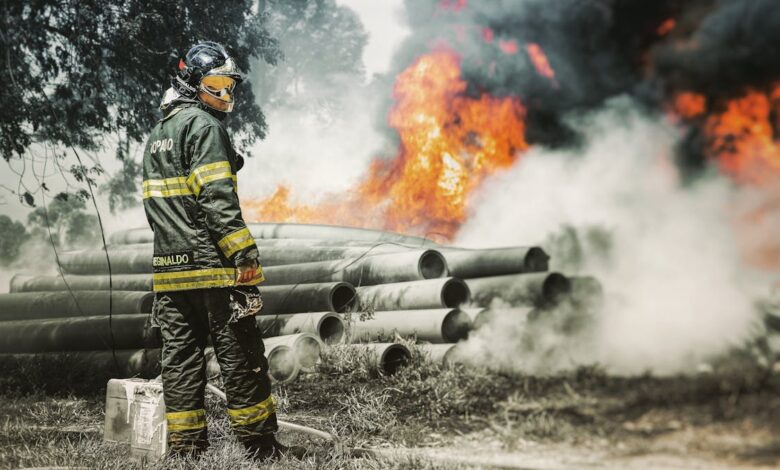Breaking Down the 5 Toxic Effects of Firefighting Foam

Toxic effects of firefighting foam, specifically aqueous film-forming foams (AFFF), has been a critical tool in managing large-scale fires, particularly those involving flammable liquids. These foams are praised for their efficiency in suppressing intense fires by creating a film that isolates the fuel from oxygen.
However, due to their harmful effects, the chemicals in these foams—specifically, per- and polyfluoroalkyl substances (PFAS)—have come under investigation. PFAS are man-made compounds that have gained the nickname “forever chemicals” due to their resistance to degradation and environmental persistence.
Widespread usage of firefighting foams containing PFAS has resulted in serious environmental damage and related health hazards. This issue has prompted numerous lawsuits, heightened regulatory actions, and a search for safer alternatives.
In this article, we will explore the general toxicity of firefighting foam and examine ongoing legal and regulatory efforts. Our goal is to provide a comprehensive understanding of the dangers posed by these foams.
Firefighting Foam Toxicity
Firefighting foam toxicity is primarily linked to its chemical composition. PFAS, the main component of many firefighting foams, exhibits outstanding heat, water, and oil resistance, contributing to their remarkable efficacy in fire control. However, these same properties make PFAS persistent in the environment and in the human body.
ATSDR notes that because of their frequent usage, PFAS are found in the bodies of humans and animals all over the world. Once released, PFAS can contaminate soil, water, and air, leading to widespread environmental distribution and long-term exposure risks.
Firefighting Foam Lawsuits
The growing awareness of PFAS toxicity has led to numerous lawsuits against manufacturers and users of PFAS-containing firefighting foams. Plaintiffs in these cases typically include municipalities, water districts, and individuals who have suffered health issues or environmental damage due to PFAS contamination.
Major chemical companies, such as 3M and DuPont, have faced substantial legal challenges. This has resulted in significant financial settlements and increased scrutiny of their practices. Yahoo! Finance notes that the companies have agreed to pay more than $15 billion in PFAS settlements.
The firefighting foam lawsuit has been pivotal in raising public awareness and pushing for stricter regulations.
They have also highlighted the need for comprehensive cleanup efforts and the development of safer fire suppression alternatives. TorHoerman Law notes that the legal landscape surrounding firefighting foam is evolving rapidly, with ongoing litigation likely to shape future policies.
Environmental Contamination
One of the most pressing concerns related to firefighting foam is its environmental contamination. PFAS are notorious for their persistence in the environment, often remaining intact for decades. When firefighting foam is used, these chemicals can seep into the ground, contaminating soil and groundwater.
This contamination can spread over large areas, affecting water supplies and ecosystems far from the initial site of application. Environment America reports that roughly 46 million Americans are being supplied PFAS-contaminated water.
The ecological impact is profound. PFAS can accumulate in wildlife tissues, leading to bioaccumulation in the food chain. This means that even top predators, including humans, can experience high levels of PFAS due to the consumption of contaminated food and water.
The widespread presence of PFAS in the environment presents a daunting challenge for environmental cleanup efforts. It requires advanced remediation technologies and significant financial resources.
Health Risks to Human Life
The dangers of being exposed to PFAS are numerous and well-documented. PFAS has been connected to a number of harmful health effects, such as thyroid illness, cancer, liver damage, and developmental problems in children. The fact that PFAS can build up over time in the human body is one of their most worrisome characteristics.
PFAS accumulates in the bloodstream and can cause serious health issues even with small, regular exposures. Particularly at risk are military personnel and firefighters who deal with firefighting foams on a regular basis. These demographics had higher blood test results for PFAS, which is associated with a higher likelihood of connected health problems.
Communities near contaminated sites also face increased risks, particularly if their drinking water sources are affected. Addressing these health risks requires stringent regulations, improved monitoring, and effective public health interventions.
Impact on Drinking Water
Drinking water contaminated with PFAS is a serious public health risk. Once PFAS get into the water system, it might be difficult to get rid of them with conventional water treatment methods. As a result, PFAS levels in drinking water have been observed to be higher than recommended by health advisory standards in numerous areas worldwide.
Chronic health problems might arise from drinking tainted water over an extended period of time. This highlights the requirement for thorough water quality monitoring and efficient filtering technology.
Reverse osmosis and activated carbon are two examples of sophisticated filtration methods that have been implemented in an effort to lessen this impact. This can lower the amount of PFAS in drinking water. To safeguard the public’s health, regulatory bodies are also imposing stronger restrictions on the permissible levels of PFAS in drinking water.
Soil and Agricultural Impact
The contamination of soil by PFAS from firefighting foam poses a significant threat to agriculture. PFAS can persist in soil, leading to long-term contamination of agricultural lands. This can result in the uptake of PFAS by crops, which then enter the food chain. Livestock consuming contaminated water or feed can also accumulate PFAS in their tissues, further spreading the contamination.
The agricultural impact extends to food safety, as contaminated produce and animal products can pose health risks to consumers. Addressing soil contamination requires extensive testing, soil remediation techniques, and careful management of agricultural practices. Farmers and food producers must be vigilant in monitoring and mitigating PFAS contamination to ensure the safety of their products.
FAQs
How long does PFAS stay in the body?
PFAS can stay in the body for many years, with a half-life of nearly four years. They primarily leave the body through urine, and small amounts can enter through skin contact, persisting for extended periods.
Does 3M still make AFFF?
No, 3M no longer makes AFFF. The company stopped producing and selling AFFF over a decade ago and now assists former customers in properly handling unused AFFF.
Does boiling water destroy PFAS?
No, boiling water does not destroy PFAS. Instead, it concentrates the chemicals, making the water even more hazardous to drink, as heat cannot break down PFAS compounds.
In conclusion, addressing the toxic effects of firefighting foam containing PFAS is crucial due to its extensive environmental and health impacts. The persistence of PFAS, coupled with ongoing legal battles and regulatory actions, underscores the need for safer alternatives. Effective strategies must include advanced remediation technologies and stringent regulations to mitigate contamination.
Prioritizing public health through comprehensive monitoring and improved water treatment is essential. As the legal landscape evolves, developing policies that prevent future contamination and ensure environmental and human safety is critical. Collaboration between industries, governments, and communities will be key to achieving these goals.



